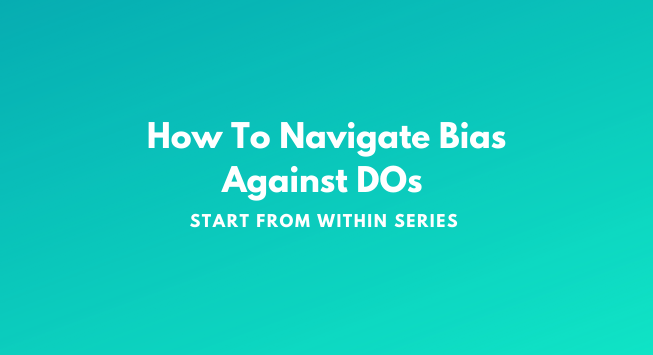
Recently, there’s been a lot of bias toward Doctors of Osteopathic Medicine.
When President Trump was diagnosed with COVID-19, White House Physician and Navy Physician, Dr. Sean Conley, DO, gave updates on his illness and treatment. Media outlets questioned why President Trump’s care was overseen by an “osteopath” rather than an infectious disease specialist or an internist, and some even implied that Dr. Conley isn’t a “real doctor.”
Then a scrubs brand came under fire for having a video on their website that depicted a female DO reading a “Medical Terminology for Dummies” book upside down.
DOs are fully licensed physicians equivalent to MDs, who’ve gone through similar medical training, and can practice in ANY specialty. So what’s with all the bias against DOs?
Are Osteopathic Programs Easier Than Allopathic Programs?
Bias against DOs has been around for awhile—and it’s based on common misconceptions. Today, 11% of practicing physicians in the U.S. and 25% of medical students in the country are DOs or soon-to-be DOs. In the U.S., there's a rising interest in holistic health and wellness, so demand for DOs is climbing too.
Whether you’re an MD or a DO, you’ve probably heard this inaccuracy—that osteopathic programs are easier to get into than allopathic programs. The truth is, the curriculum for both types of medical training is similar, with one slight difference: osteopathic programs focus on preventive medicine, considering a patient’s whole life and social factors that could contribute to their health outcomes.
The big difference in osteopathic medical schools and allopathic medical schools is that osteopathic programs include two additional principles in their medical training: a holistic approach to medicine and mind/body/spirit wellness, and their 200+ hours of training on the musculoskeletal system.
The curriculum is so similar between osteopathic and allopathic programs that, starting this year, MDs and DOs are put into the same accreditation pool to compete for the same residency training positions.
How To Navigate Questions About MD Versus DO
When someone asks you the difference, be prepared to answer. The AOA has some suggestions that can help, too.
What kind of medical training does a DO go through? How’s it different from the training an MD goes through?
Medical schools for DOs and MDs are very similar. The biggest difference is that DO schools have an additional focus on holistic medicine. Typically, a medical student in a DO school will spend an additional 200+ hours training on the musculoskeletal system.
What is the difference in licensing between DO and MD?
Both MDs and DOs take licensing exams at the end of med school or during early residency. DOs take the COMLEX exam, and MDs take the USMLE exam. DO students can choose which exam they take, or take both the COMLEX and USMLE. Both exam scores are accepted by residency programs, as MD and DO doctors are fighting for the same residency spots after graduation.
The main difference is that the COMLEX also tests on osteopathic manipulative medicine. Additionally, the COMLEX is also a longer exam—400 questions divided into 8 blocks. The USMLE exam has 280 questions divided into 7 blocks.
What does continuing medical education (CME) look like for DO versus MD?
CME is required by state medical licensing boards and specialty certifying boards for both DOs and MDs. For specialty certifying boards, the ABIM, AOBIM, ABP, and AOBP all have their own continuing education requirements that physicians need to complete in order to maintain their certification.
Ultimately, both designations require an immense amount of focus, dedication, education and a commitment to the craft of medicine. There should be no reason to discredit either one. And, both MDs and DOs use the same MedStudy solutions to prepare for their board exam, update their knowledge for practice, and earn CME/MOC. We're committed to supporting both MDs and DOs throughout their career and lifelong learning.
This is one in a series of blogs, Start From Within, where we’re tackling topics like healthcare inequity, the elements of professionalism you aren't taught in med school, what to do when patients have a bias, etc.
Our mission is to make learning medicine easier. But we know it’s not just how you learn medicine—the way you apply your knowledge in clinical settings is immensely important, too. This blog series is meant to help you navigate the patient situations you face daily and improve your patient care.


